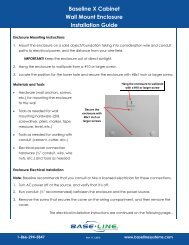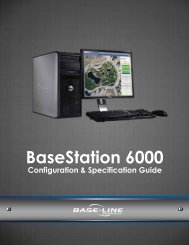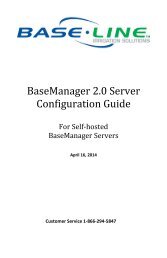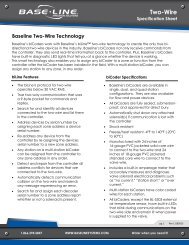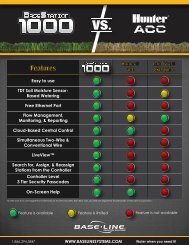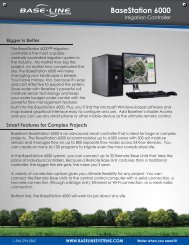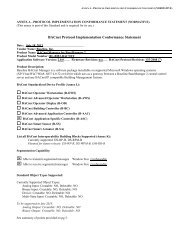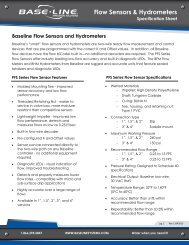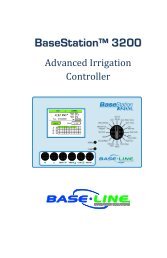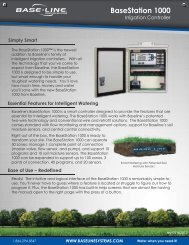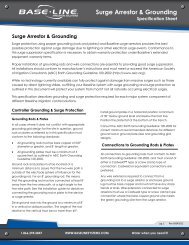BaseStation 3200 User Manual â 11.7.5.15 ... - Baseline Systems
BaseStation 3200 User Manual â 11.7.5.15 ... - Baseline Systems
BaseStation 3200 User Manual â 11.7.5.15 ... - Baseline Systems
You also want an ePaper? Increase the reach of your titles
YUMPU automatically turns print PDFs into web optimized ePapers that Google loves.
<strong>BaseStation</strong> <strong>3200</strong> Advanced Irrigation Controller <strong>Manual</strong><br />
To set up the day intervals for a program<br />
1. Turn the dial to the Day Intervals position.<br />
2. Press the + or – button to select the program that you want to set up<br />
day intervals for.<br />
3. Press the NEXT button to move to the field where you select the<br />
interval that you want.<br />
4. Press the + button to move through the options, and then stop when<br />
the option that you want to use is displayed in the field.<br />
Note: Refer to the topic for setting up the Historical ET Calendar mode<br />
on page 49.<br />
5. For some options, you need to set up the schedule. Press the NEXT button to move to the schedule. The<br />
selected day is highlighted blue.<br />
6. Press the + or – button to change that day from a watering day (indicated by Y for “yes”) to a non-watering<br />
day (indicated by – for “no”).<br />
7. When you have finished making changes, turn the dial to the Auto Run position.<br />
Note: A program that is started on one day will continue to run until it completes, even if it needs to continue<br />
to the next day, which may or may not be a watering day. For example, if a six-hour program starts at 10 PM<br />
on Monday, it will finish at 4 AM on Tuesday, even if Tuesday is not a watering day.<br />
To set up historical ET-based watering for a program<br />
In the <strong>BaseStation</strong> <strong>3200</strong>, one of the Day Interval modes for a program is Historical ET Calendar. Evapotranspiration<br />
(ET) refers to the loss of moisture from the soil by evaporation and by the transpiration of plants. Factors such as<br />
air temperature, humidity, solar radiation, and wind speed affect the rate at which ET occurs. Scientists with the<br />
National Oceanic and Atmospheric Administration (NOAA) continuously monitor climate data in all regions of the<br />
United States. When this data is averaged over a 30 year period, historical ET values are generated for each month<br />
of the year.<br />
The Historical ET Calendar mode enables you to set up a watering schedule for the entire year that compensates<br />
for seasonal changes without your having to adjust times and frequency multiple times throughout the year. Bear<br />
in mind that a historical ET-based watering schedule works best in regions where landscapes are irrigated all year.<br />
If you set up a run time that applies ½ inch of water and then you change the frequency of watering based on the<br />
historical ET needs for your area, the controller will water deeply and less frequently and encourage the roots of<br />
your plants to grow deep.<br />
Prerequisites<br />
• Set zone water times that will apply ½ inch of water during each watering cycle.<br />
• Get the historical ET deficit data for your region. Consult with your local Agricultural Cooperative Extension<br />
office – you can find a national register of the extension offices at: http://www.csrees.usda.gov/Extension/<br />
• Split each month of the year in half and determine how frequently you will need to water in order to replace,<br />
but not exceed, the amount of moisture used by your plant material since the last irrigation event. Use the ET<br />
deficit data to determine the watering frequency.<br />
Note: If you combine the Historical ET Calendar mode with the upper limit watering strategy using biSensors,<br />
you will have a very effective watering schedule. The biSensor will monitor the soil moisture in real-time and<br />
compensate for non-historical weather behavior by making fine adjustments to the run time.<br />
Page 49



